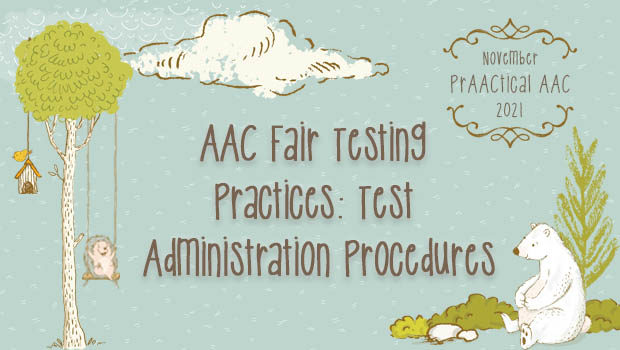AAC Fair Testing Practices: Test Administration Procedures

Without a thoughtful assessment plan in place, people who use AAC may be at a disadvantage when taking tests. Fatigue, excessive anxiety, comprehension difficulties, motor challenges, limited access to robust language, and other factors may make it difficult for them to demonstrate what they know. Today, we continue our series on AAC Fair Testing Practices with a discussion of test administration practices.
In formal testing, any changes to testing procedures invalidate the use of normative data. If we modify the directions or response options provided to an AAC user, we can’t compare their scores to the scores of individuals who took the test without any modifications. That means we aren’t pouring through the tables at the back of the test manual to find age or grade equivalency scores.
Still, we have to be thoughtful in when and how to make adjustments to testing practices. In this post, we consider two specific aspects of test administration: a) prompts and cues, and b) feedback and reinforcement.
And for those who are new to this topic, here are links to the previous posts in this series.
- What Are AAC Fair Testing Practices & Why Should We Use Them?
- Preparation for the Assessment
- Modes of Responding in Tests & Assessments
- The Testing Environment
- Test Materials
TOPIC 10: What prompts and cues are allowed and beneficial?
Formal test manuals generally provide explicit information on what the examiner can and cannot say when prompting is needed. One test may allow us to repeat the question but not rephrase it. Another allows the examiner to encourage more thorough responses by saying things like ‘Tell me more.’
AAC users, however, particularly those who are not yet proficient with the SGDs, may need prompts and cues beyond what the manual allows. In these situations, teams can talk through the different test situations and decide what kinds of prompts they feel are necessary for the individual to generate responses that more closely match their skill level.
Teams may want to consider what prompts would be allowable when the AAC user faces situations like these.
- The question uses words they don’t understand (e.g., “Jane’s mom said ‘I guess we better fasten up!’ but they weren’t even in the car. What did Jane’s mom mean?” “Select 3 problems and complete them.”)
- Participation in the testing is waning, and the individual is increasingly reluctant to respond.
- The person doesn’t appear to understand what the question is asking them to do (e.g., “When I say go, tell me all the animals you can think of” “Rabbits. I really love rabbits. Rabbits are my favorite.”)
- The individual seems hesitant and unsure of how to answer (e.g., “You can tell me with your mouth words or with your Talker or any other way you want.”)
- The person needs some guidance to construct their answer (e.g., “Think about whether you want to start with a People word or an Action word or something else.”).
- The individual doesn’t respond at all.
TOPIC 11: What feedback is permitted and beneficial?
Feedback plays a small but important role in the test-taking experience for some people who use AAC. In testing situations, the purpose of feedback is not to steer people to the correct answer, but rather to support them in the test-taking process so that we can unearth what they really know.
- Leisl is a student whose attention wanders when bored, and she sometimes deals with that by navigating to a screen on her SGD that lists her favorite anime characters. To redirect the situation, she often says their names whether or not that is a good fit for the content.
- Harris hates being wrong and frequently seeks feedback on whether his response was correct or incorrect. He can get quite irate when his communication partner fails to comment on his response.
- Mason gets quite anxious when faced with new experiences, particularly challenging ones like taking a test or quiz. When answering test questions, he often looks to the examiner for reassurance.
- Cyril moves through life at a dizzying pace. In testing situations, he’s eager to please and sometimes answers before the examiner finishes asking the question.
In each of these situations, there are constraints in how the assessor should respond. For formal tests, we can look to the test manual to get information on what kind of feedback is permissible. Teams can then discuss any adjustments that might need to be made when testing a particular student who uses AAC. They may want to plan out things like how an assessor should handle feedback such as:
- Validating feelings and emotions (e.g., “It’s okay to feel a little nervous.” “Taking a test can be scary. It’s okay to feel a little scared.”)
- Providing reassurance (e.g., “You’re working really hard. Thank you for that.” “This is no fun, but you’re doing it. You should be proud of yourself.”)
- Clarifying expectations (e.g., “Next time, wait until I point to you before you respond.” “Remember, look at ALL the pictures before you choose.”)
- Giving information about the testing process (e.g., “We have 5 more left and then we’ll take a break” “When you point with your thumb instead of your whole hand, I can see exactly which one you want.”)
- Helping with self-regulation (e.g., “Remember, you can ask for a break.” “Do you want to do some square breathing before we move on?”)
Are there other things that AAC teams should be considering relative to how the assessment is administered? Share your ideas in the comment section below.
Filed under: Featured Posts, PrAACtical Thinking
This post was written by Carole Zangari
